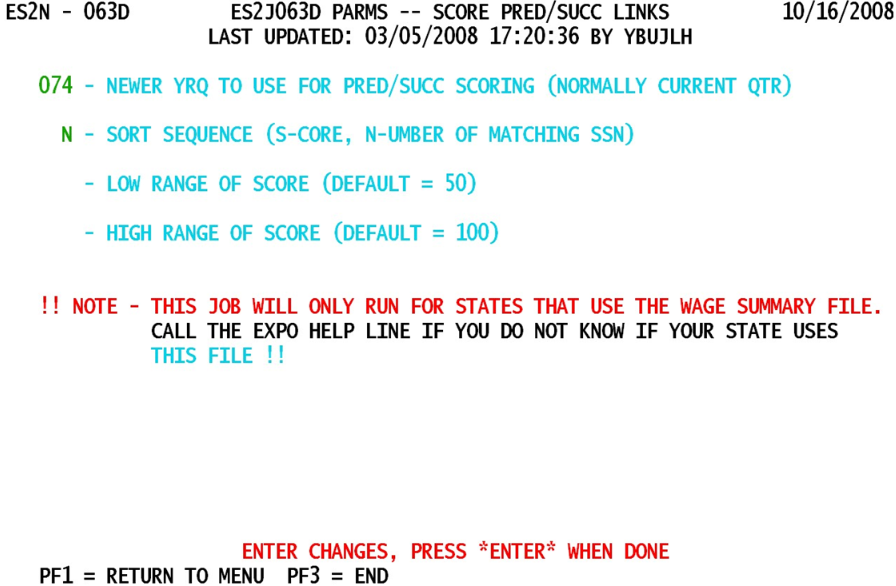14 job 063d predecessor successor linkage scoring
Job 063D - Predecessor / Successor Linkage Scoring
Job 063D processes a scoring algorithm to compare potential predecessor/successor pairs to determine which ones seem likely candidates for a true transfer relationship. The algorithm examines various components, such as ZIP code, NAICS code, legal name, etc., to assign a score value for the relationship. The higher the score, the more likely it appears that the relationship is genuine.
As the warning note on the screen indicates, the job will only work properly if the Wage Summary File is maintained in the State. The file (which displays on the refiling-related screen of ES2C) shows quarterly wage record counts and wage record wages, which are compared to employment and wage values in the micro record. The wage record counts are examined to determine eligibility for the predecessor/successor scoring test.
1. Newer YrQ to Use for Pred/Succ Scoring (normally current qtr) - Although this can be set to any quarter that is present on the applicable files (Micro File, Wage Summary File, and Predecessor/Successor Potentials File), it is most common to analyze current quarter data. The format is the standard YYQ layout.
2. Sort Sequence (S-core, N-umber of Matching SSN) - This switch determines whether the report will appear in order of most likely candidates (highest score) or the largest candidates (SSN count).
- a. ‘S’core - This sort will have the highest-scoring potential pairs listed first, with the lowest scores last. The potential pairs on top of the report have the highest likelihood (according to the scoring algorithm) of being linked.
- b. ‘N’umber of Matching SSNs - This sort picks out the accounts that have the highest count of wage records associated with the relationship. They may have little in common (address, phone number, name, etc.), but the number of sheer number of employees can draw attention to these potential pairings.
3. Low Range of Score (Default = 50) - Any potential pairing with a score lower than this value will not be listed, since they seem too dissimilar to investigate. Though the default is 50, any value from zero up can be applied.
4. High Range of Score (Default = 100) - Sets the upper limit for predecessor/successor scores to include in the report. Normally set to the default (100), the value could be set to a lower value. Generally, lower values will only be needed if the first run (e.g., with a range of 75-100) failed to find enough strong candidates, so a follow-up run with a 50-75 range is in order.
Job 063D can be run at any time. However, it is generally most helpful to run near the end of the quarterly processing, so that late-arriving wage record data can be included in the analysis. The output will often be fairly sparse, since the scoring algorithm can be fairly exclusive with most of the potential match-ups.
Related Links
